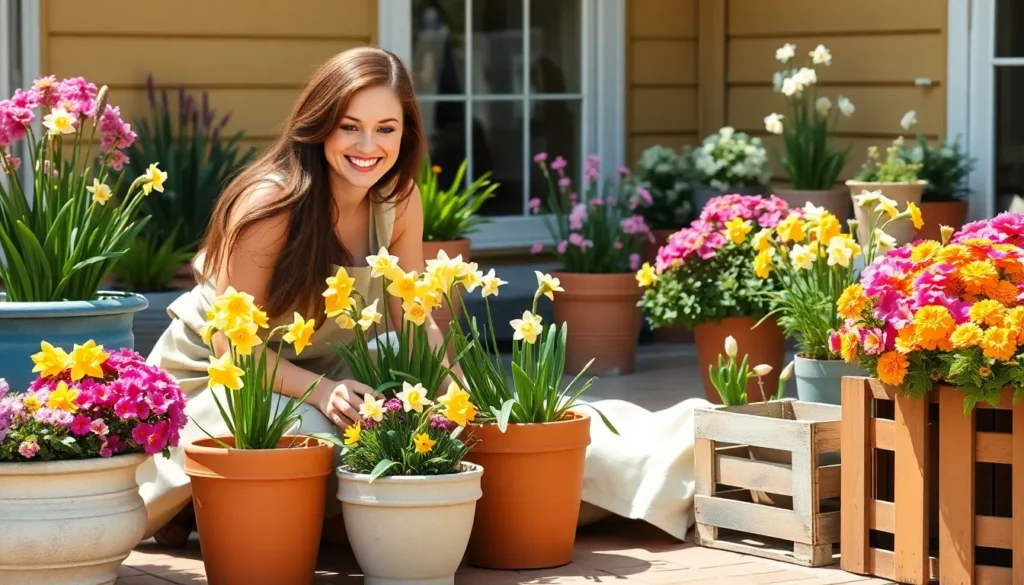Spring’s arrival brings that familiar itch to refresh our outdoor spaces and breathe new life into gardens that have been dormant all winter. There’s something magical about creating beautiful planters that welcome the season with vibrant colors and fresh growth.
We’ve discovered that the right spring planter can transform any space – whether you’re working with a tiny balcony apartment or a sprawling backyard. The beauty lies in choosing containers and plants that work together to create stunning displays that’ll make your neighbors stop and stare.
From choosing the perfect container combinations to selecting plants that thrive in spring’s unpredictable weather we’ll share practical ideas that work for every skill level and budget. These aren’t just ordinary planters – they’re conversation starters that’ll have everyone asking for your secret to creating such gorgeous displays.
Choose the Perfect Spring Containers for Your Planter Display
Selecting the right containers sets the foundation for stunning spring planter displays that capture attention and complement your outdoor aesthetic.
Traditional Terra Cotta Pots and Saucers
Terra cotta containers remain our top choice for spring planters due to their natural drainage properties and classic appeal. These clay vessels allow plant roots to breathe while preventing waterlogged soil conditions that can damage delicate spring blooms.
We recommend choosing pots with drainage holes and matching saucers to protect surfaces from water damage. Standard sizes range from 6-inch diameter pots for herbs like basil and thyme to 14-inch containers perfect for larger displays featuring tulips or daffodils.
Weathered terra cotta develops beautiful patina over time, creating an authentic garden look that pairs excellently with cottage-style landscaping. Price points typically start at $8 for smaller pots and reach $35 for premium large containers with decorative rim details.
Modern Fiber Cement and Concrete Planters
Fiber cement planters offer contemporary style with superior durability for spring container gardens. These lightweight alternatives to traditional stone planters resist cracking in temperature fluctuations while maintaining sleek geometric shapes.
Concrete containers provide substantial presence for statement spring displays featuring ornamental grasses like fountain grass or dramatic flowering plants such as cherry blossoms. We’ve found these materials work exceptionally well for minimalist garden designs and urban balcony settings.
Contemporary planters come in neutral tones including charcoal, white, and natural gray that complement modern architecture. Rectangular fiber cement containers measuring 24×8 inches cost approximately $75, while round concrete planters with 16-inch diameters average $65 at garden centers.
Repurposed Items as Creative Spring Containers
Vintage galvanized buckets transform into charming spring planters that add rustic character to any display. Old wooden crates work beautifully for herb gardens featuring parsley, cilantro, and chives, while antique watering cans create whimsical focal points for small flowering plants.
We encourage drilling drainage holes in repurposed containers to ensure proper water flow for healthy plant growth. Enamelware colanders make excellent hanging planters for trailing spring flowers like petunias or sweet alyssum.
Creative upcycling extends to items like vintage boots for succulent displays, old wheelbarrows for large vegetable gardens, and ceramic bowls for desktop herb collections. These unique containers typically cost under $20 at thrift stores and flea markets, making them budget-friendly options for distinctive spring planter arrangements.
Select Vibrant Spring Flowers for Colorful Planter Arrangements

Now that we’ve chosen our containers, it’s time to fill them with the most stunning spring blooms. Selecting the right flowers transforms any planter from simple to spectacular.
Early Blooming Bulbs and Perennials
Daffodils and violas create our favorite spring combination when we plant daffodil bulbs in autumn and add smaller bedding plants like violas in spring for a colorful display. These cheerful yellow blooms pair beautifully with purple violas, giving us weeks of continuous color.
Hyacinth and heuchera partnerships deliver both fragrance and foliage interest when we combine hyacinths with heuchera and early dianthus for a fragrant and colorful pot. We love how the burgundy leaves of heuchera complement the pink or white hyacinth spikes.
Spring bulb medleys offer maximum impact when we combine daffodils, hyacinths, and tulips with small evergreens and bedding plants for structure and color. These mixed plantings provide us with blooms from early spring through late May.
Acer and bleeding heart combinations work perfectly for larger containers when we use a Japanese maple, bleeding heart, ivy, and tiarellas in a large container for a more permanent display. This sophisticated arrangement gives us year round interest with spectacular spring color.
Annual Spring Flowers for Continuous Color
Bright zinnias bring summer vibes to spring planters when we use a mix of pink and yellow zinnias in different pot heights to create a vibrant arrangement on a sun drenched porch. These flowers come in a variety of colors and bloom throughout the spring and early summer.
Pansies provide us with reliable color from early spring through summer’s heat. We appreciate how these bright and resilient flowers thrive in cooler temperatures while delivering consistent blooms.
Snapdragons add vertical interest to our spring arrangements with their tall spikes of colorful flowers. These sturdy annuals keep blooming for months when we deadhead them regularly.
Sweet alyssum creates beautiful carpet effects around taller plants with its tiny white or purple flowers. We use this low growing annual as a living mulch that blooms continuously.
Fragrant Spring Blooms for Sensory Appeal
Hyacinths top our list for spring fragrance since they’re known for their strong, sweet fragrance and are a classic choice for spring planters. We position these powerfully scented bulbs near seating areas where we can enjoy their perfume.
Daffodils contribute a fresh, floral scent to spring arrangements even though they’re not as fragrant as hyacinths. Their subtle fragrance becomes more noticeable when we plant them in clusters.
Sweet peas reward us with delicate fragrance and pastel colors when we train them up small trellises in our planters. These climbing annuals fill the air with their distinctive perfume on warm spring days.
Stock flowers deliver intense clove like fragrance that carries across our entire garden space. We plant these tall spikes in the center of large planters where their scent can drift freely.
Create Stunning Seasonal Combinations with Spring Foliage Plants
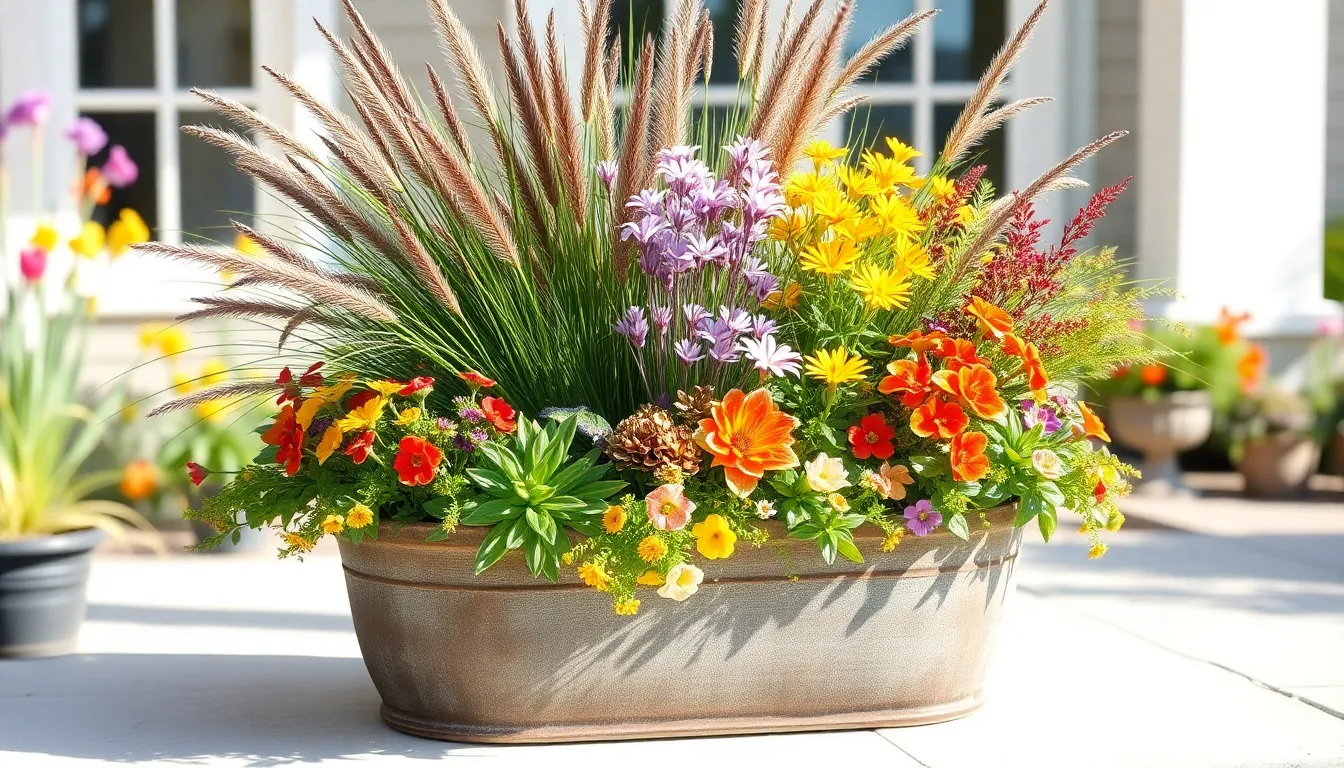
Building on our flower selections, we’ll now explore how foliage plants create the perfect foundation for stunning spring displays. Strategic layering with different plant types transforms ordinary containers into professional-looking arrangements that captivate throughout the season.
Decorative Grasses and Textural Elements
Ornamental grasses provide natural movement and rustic appeal that complements our vibrant spring blooms beautifully. Carex varieties serve as excellent filler plants, offering diverse textures and colors that bridge the gap between bold flowers and subtle foliage elements.
Thriller plants like olive trees, evergreen magnolias, or columnar apples create vertical interest and serve as focal points in larger containers. These statement pieces anchor our arrangements while providing year-round structure that extends beyond spring’s fleeting beauty.
Filler selections including heuchera and hellebores add substantial body to planters while maintaining visual interest through varied leaf shapes and colors. Carex ‘Everillo’ brings bright chartreuse tones that illuminate shadier spots, while traditional green varieties provide calming balance between more dramatic elements.
Textural diversity emerges when we combine fine-leaved grasses with broader foliage plants like ferns. This contrast creates depth and prevents our arrangements from appearing flat or monotonous, especially when viewed from different angles.
Colorful Spring Foliage for Visual Interest
Foliage colors extend our seasonal displays far beyond blooming periods, ensuring continuous appeal throughout spring’s progression. Heuchera ‘Changeling’ offers ever-shifting hues that adapt to light conditions and temperatures, providing ever-changing color variation within single containers.
Color coordination becomes effortless when we select foliage that complements our chosen flowers while maintaining interest after blooms fade. Carex varieties in bronze, gold, and deep green tones create sophisticated palettes that support rather than compete with featured flowers.
Consistent visual appeal develops through strategic placement of colored foliage plants that maintain their attractive appearance regardless of weather fluctuations. These reliable performers ensure our planters never look bare or neglected, even during transitional periods.
Seasonal progression unfolds naturally as different foliage plants reveal subtle color changes throughout spring’s advancement. Heuchera varieties shift from deep burgundy winter tones to brighter spring hues, creating living artwork that evolves with the season.
Trailing Plants for Cascading Effects
Trailing elements complete our spring arrangements by adding graceful movement and softening harsh container edges. Wire vine creates delicate cascading effects that appear effortless while requiring minimal maintenance throughout the growing season.
Spiller combinations using vinca ‘Alba’ or trailing rosemary provide both visual appeal and practical benefits like fragrance or pest deterrence. These flowing plants draw the eye downward, creating natural transitions between containers and surrounding industry elements.
Vertical gardening opportunities expand when we incorporate trailing plants in hanging containers or elevated displays. Ivy varieties and trailing rosemary work exceptionally well for porch installations or wall-mounted arrangements that maximize limited space.
Cascading arrangements achieve professional results when we balance trailing plants with upright elements, ensuring neither overwhelms the overall composition. Strategic placement of spillers prevents our displays from appearing top-heavy while maintaining the thriller-filler-spiller principle that creates visually balanced arrangements.
Design Eye-Catching Arrangements Using Color Theory Principles
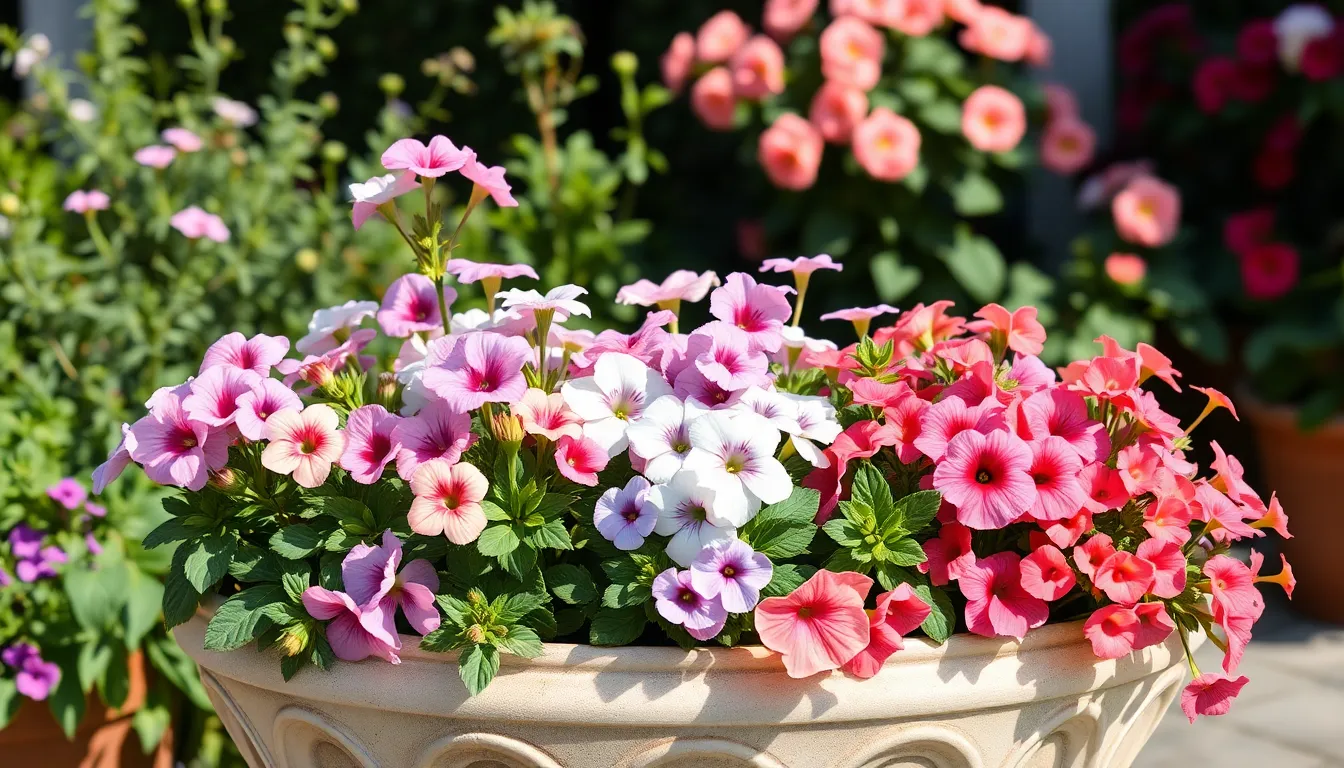
Color theory transforms ordinary planters into stunning focal points that command attention throughout your outdoor space. Understanding these principles helps us create cohesive designs that enhance rather than overwhelm our carefully selected plants and containers.
Monochromatic Spring Planter Schemes
Monochromatic arrangements use different shades of the same color to create sophisticated unity in our spring displays. We can achieve striking results by combining various blue tones, from deep navy violas to pale powder blue lobelia, creating depth while maintaining visual harmony.
Pastel monochromatic schemes work exceptionally well for spring planters, offering gentle transitions that complement the season’s fresh energy. Pink arrangements might feature deep rose geraniums paired with blush colored petunias and pale pink sweet alyssum cascading over container edges.
Lavender schemes create calming focal points by combining different purple tones, from rich violet pansies to soft lilac bacopa. Peach monochromatic displays bring warmth to our arrangements through coral impatiens, salmon colored begonias, and creamy apricot calibrachoa.
Complementary Color Combinations for Maximum Impact
Complementary colors sit opposite each other on the color wheel, creating dramatic contrasts that make our planters pop against any backdrop. Blue and orange combinations deliver stunning visual impact through bright orange marigolds paired with deep blue lobelia or sky blue ageratum.
Red and green partnerships offer bold statements that work particularly well in formal settings or contemporary landscapes. We can achieve this through red geraniums planted in sage green containers or red ceramic pots filled with vibrant green foliage plants like coleus.
Yellow and purple combinations create cheerful displays that capture spring’s optimistic spirit through golden marigolds combined with deep purple petunias. These contrasting pairs naturally draw the eye and create memorable focal points in our outdoor arrangements.
Seasonal Color Palettes for Spring Gardens
Spring’s signature pastel palette includes soft pink, lavender, and peach tones that mirror the season’s gentle awakening. These hues work beautifully together in mixed planters, creating romantic displays that complement both traditional and cottage garden styles.
Vibrant spring combinations featuring bright yellows, oranges, and reds reflect the season’s increasing warmth and energy. We can incorporate sunny yellow pansies, coral colored impatiens, and cheerful red tulips for arrangements that celebrate spring’s vitality.
Nature inspired palettes using earthy colors like terracotta and sage create sophisticated displays that blend seamlessly with outdoor surroundings. These neutral tones provide perfect backdrops for colorful blooms while maintaining visual balance throughout our garden spaces.
Build Successful Spring Planters with Proper Layering Techniques
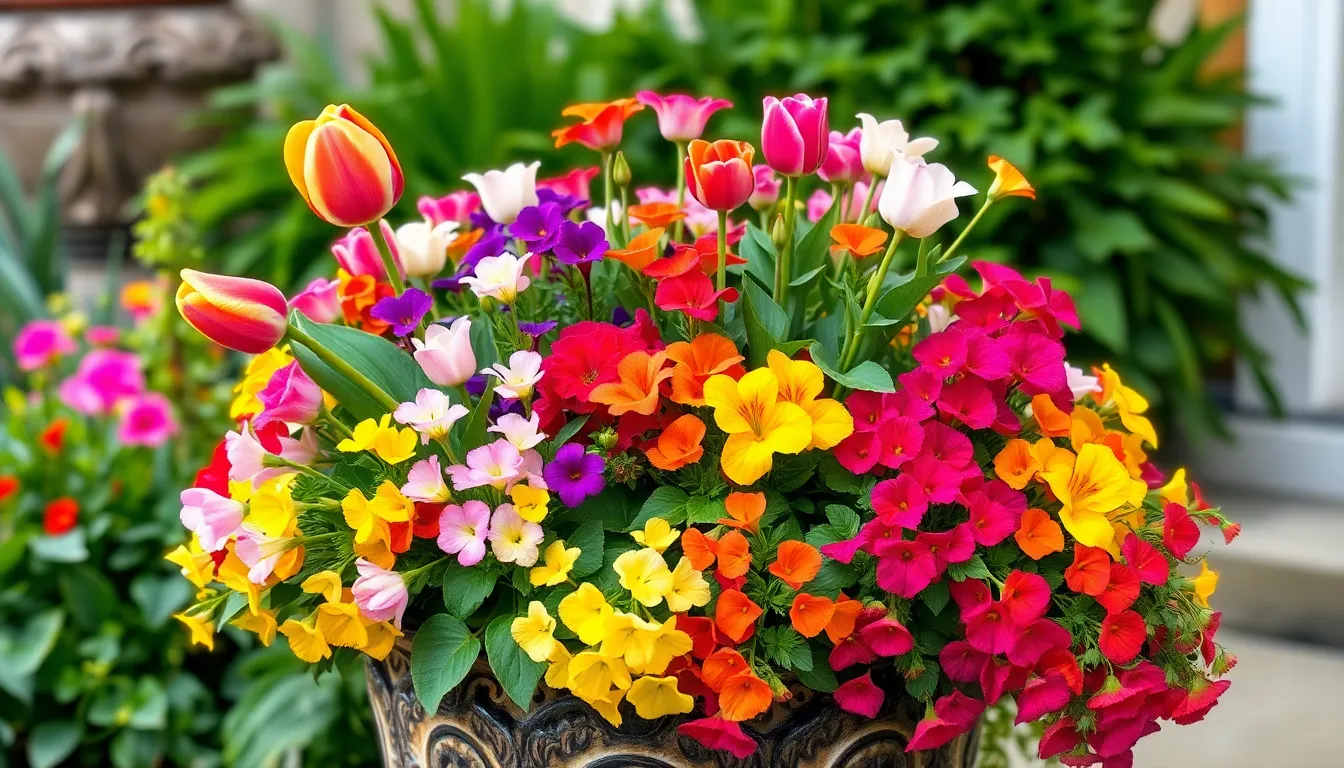
Creating stunning spring displays requires strategic layering that mimics nature’s own growth patterns. We’ll guide you through the three essential tiers that transform ordinary containers into breathtaking focal points.
Foundation Plants and Structural Elements
Taller plants form the backbone of every successful spring arrangement by establishing visual hierarchy. Position these statement pieces toward the back of containers to create dramatic backdrops that allow shorter plants to shine in the foreground. Structural elements like Dusty Miller bring sophisticated silver tones and interesting foliage textures that anchor your entire composition.
Backdrop plants typically range from 12 to 24 inches tall and provide the canvas for your creative vision. Choose specimens with strong vertical lines or interesting architectural forms to establish the planter’s personality. These foundational elements create depth while ensuring that mid-level and accent plants receive proper spotlight positioning.
Foliage plants with unique textures add year-round interest beyond blooming periods. Incorporate Muehlenbeckia for its delicate, wiry stems that create airy movement throughout your arrangement. These structural components maintain visual appeal even when seasonal flowers fade.
Mid-Level Filler Plants for Fullness
Filling plants create the lush, abundant look that makes spring planters irresistible to admirers. Bacopa cascades gracefully over container edges while producing masses of tiny white or purple blooms throughout the growing season. Calibrachoa delivers non-stop color in vibrant shades that complement any spring palette.
Lobularia sweetens the air with its honey-like fragrance while forming dense mats of delicate flowers. These mid-level performers typically grow between 3 to 12 inches tall, creating perfect transitions between foundation and accent plants. Layer these specimens thoughtfully to maintain visual flow and prevent gaps that can make arrangements appear sparse.
Cascading varieties soften hard container edges and create natural-looking compositions. Choose plants that spill over sides without overwhelming the overall design balance. These workhorses fill spaces efficiently while contributing continuous color and texture throughout spring.
Accent Plants and Finishing Touches
Colorful blooms provide the wow factor that draws attention and creates memorable displays. Tulips offer classic spring elegance in countless varieties, from simple singles to dramatic doubles. Geraniums contribute bold, cheerful colors that withstand spring’s unpredictable weather patterns.
Petunias deliver trumpet-shaped flowers in an incredible range of colors and patterns. These accent plants should represent roughly 30% of your total planting to maintain proper visual balance. Position them strategically throughout the arrangement rather than clustering them in one area.
Trailing plants like Muehlenbeckia create finishing touches that elevate amateur attempts into professional-looking displays. These spillers soften harsh container lines while adding movement and grace to static arrangements. Repeat container colors rather than flower colors throughout your design for greater flexibility and sophisticated unity.
Quality potting soil with excellent drainage prevents waterlogging that kills spring plants before they reach their peak. Add small pots or drainage materials to container bottoms to ensure proper water flow and healthy root development.
Maintain Your Spring Planters for Long-Lasting Beauty
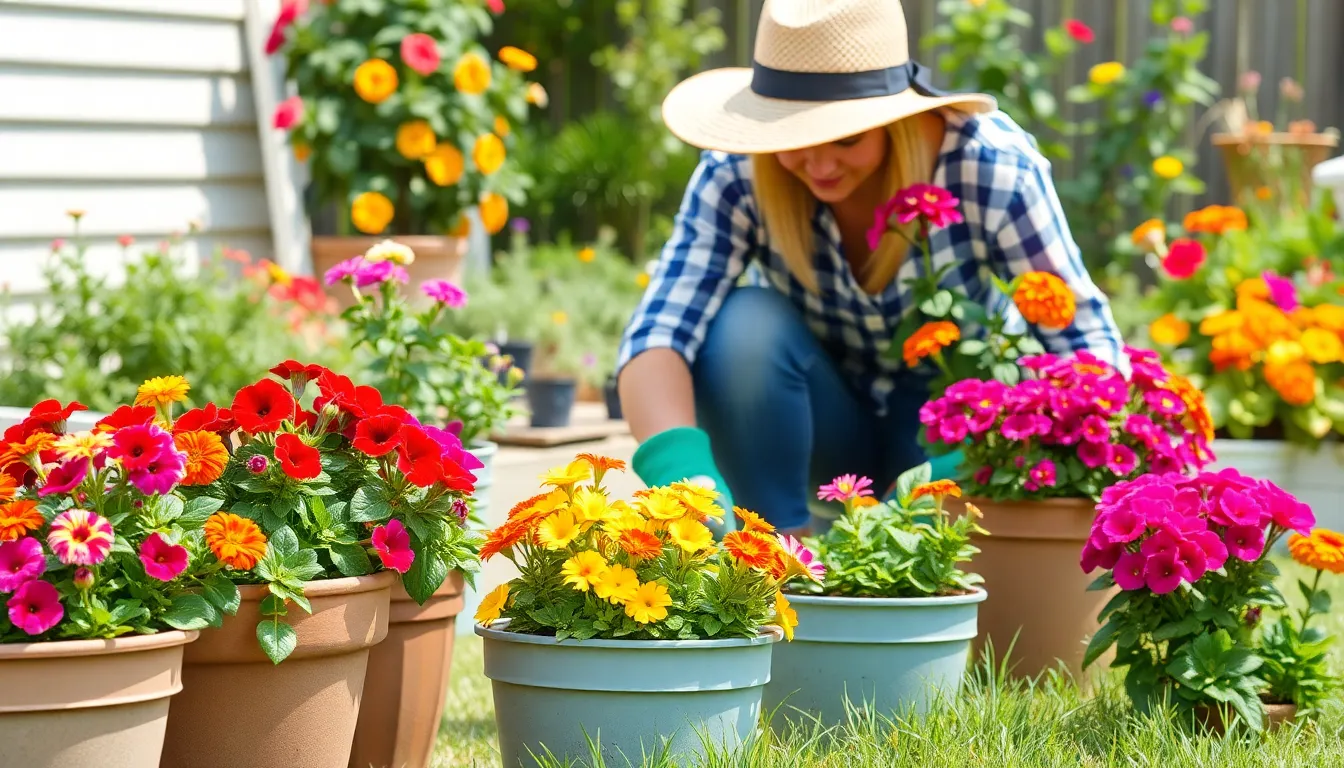
We’ve invested time and creativity into crafting beautiful spring displays, so proper maintenance ensures our planters remain vibrant throughout the entire season. Keeping these containers healthy requires attention to watering schedules, fertilizing needs, and seasonal transitions.
Proper Watering Schedules for Spring Weather
Spring’s unpredictable weather patterns make watering schedules particularly challenging for container gardeners. We should check soil moisture by inserting our finger into the top inch of potting mix before adding water. Dry soil at this depth indicates it’s time to water thoroughly until excess drains from the bottom.
Weather conditions directly influence how often we need to water our spring planters. Cool, cloudy days require less frequent watering than warm, sunny periods when containers dry out faster. Container plants need more frequent watering than ground plantings because their roots can’t access surrounding soil moisture.
Morning watering gives plants time to absorb moisture before afternoon heat increases evaporation rates. We avoid evening watering sessions that can promote fungal diseases in cool, damp spring conditions. Consistent moisture levels prevent stress that causes flowers to drop prematurely or foliage to wilt.
Fertilizing Requirements for Container Plants
Container plants rely entirely on us for their nutritional needs since they can’t access nutrients from surrounding garden soil. We apply balanced fertilizer once monthly during the growing season to support healthy development and continuous blooming. Balanced formulations provide equal amounts of nitrogen, phosphorus, and potassium that spring flowers need most.
Organic fertilizers offer sustainable nutrition that releases slowly over time without burning delicate root systems. Compost tea, fish emulsion, and granular organic blends work exceptionally well for spring container gardens. These natural options improve soil structure while feeding beneficial microorganisms that support plant health.
Liquid fertilizers provide quick nutrition that plants absorb immediately through their root systems. We dilute liquid fertilizers according to package directions and apply them every two weeks during peak growing periods. Over fertilizing causes excessive foliage growth at the expense of flower production.
Seasonal Care and Transition Planning
Late winter preparation sets the foundation for successful spring planter displays throughout the growing season. We clean containers thoroughly and refresh potting soil to eliminate disease organisms and salt buildup from previous seasons. Fresh soil provides better drainage and nutrition than reused potting mix.
Transition planning becomes crucial as spring temperatures rise and cool season plants begin declining. We gradually replace spent pansies, primulas, and other cool weather favorites with heat tolerant annuals like petunias and marigolds. This staged approach maintains continuous color without shocking remaining plants.
Plant health monitoring helps us identify problems before they become serious issues affecting entire containers. We remove spent flowers regularly to encourage continued blooming and prevent energy waste on seed production. Pruning leggy growth keeps displays compact and attractive while promoting new growth from the base.
Repotting becomes necessary when roots become crowded or soil quality deteriorates significantly. We watch for roots growing through drainage holes or water running straight through containers without being absorbed. These signs indicate it’s time to move plants to larger containers or refresh the growing medium entirely.
Style Different Areas with Targeted Spring Planter Ideas

Different outdoor spaces require exact approaches to maximize their visual impact and functionality. Each area offers unique opportunities to showcase your spring planter creativity while addressing practical considerations.
Front Porch and Entryway Welcome Displays
Colorful flower arrangements create an immediate first impression that welcomes guests with vibrant energy. Tulips, daffodils, and pansies deliver that cheerful spring atmosphere we’re all craving after winter’s end. Contrasting colors like red and yellow produce striking visual combinations that catch the eye from the street.
Greenery and foliage provide the essential foundation that supports and complements your flowering displays. Coleus and caladium add rich texture and depth to entryway containers while maintaining visual interest throughout the growing season. These plants create sophisticated backdrops that make colorful blooms pop even more dramatically.
Scale considerations matter significantly when designing front porch displays that complement your home’s proportions. Large planters work best for spacious porches while smaller containers suit compact entryways without overwhelming the space. Grouping multiple containers of varying heights creates ever-changing arrangements that draw visitors toward your front door.
Patio and Deck Container Garden Arrangements
Vibrant color palettes transform outdoor living spaces into sophisticated retreats that reflect current design trends. Pantone’s “Mocha Mousse” and Sherwin Williams’ “Quietude” provide elegant neutral bases that we can accent with pops of vibrant red Calibrachoa for contemporary appeal.
Layered planting techniques maximize visual impact by combining plants of different heights and growth habits within single containers. Snapdragons create vertical drama while sweet potato vine trails gracefully over container edges. This approach delivers the lush, full appearance that makes patios feel like professional industry installations.
Functional arrangements serve dual purposes by providing beauty while defining outdoor living zones. Strategic planter placement creates natural boundaries between dining and lounging areas without blocking sightlines. Consider mobility when selecting containers since patio arrangements often need repositioning for entertaining or seasonal changes.
Window Box and Hanging Basket Designs
Trailing plants create the cascading effects that make window boxes and hanging baskets truly spectacular from any viewing angle. Ivy and creeping Jenny spill elegantly over edges while providing continuous green interest throughout the growing season. These plants soften hard container lines and create natural transitions between architectural elements and garden spaces.
Spring floral arrangements bring seasonal celebration directly to eye level where they’re most appreciated daily. Hyacinths and primrose add variety and color while delivering the fragrance that makes spring containers so memorable. Window box plantings benefit from frequent flower rotation to maintain peak appearance throughout the season.
Maintenance accessibility requires careful planning since window boxes and hanging baskets present unique care challenges. Position containers within easy reach for watering and deadheading or install pulley systems for higher installations. Proper drainage becomes even more critical in elevated plantings where excess water can damage building materials below.
Conclusion
Spring offers us endless possibilities to transform our outdoor spaces into vibrant showcases that reflect our personal style. We’ve explored everything from selecting the perfect containers to mastering color combinations and layering techniques that create professional-looking displays.
The key to successful spring planters lies in thoughtful planning and understanding what works best for your exact space and lifestyle. Whether you’re working with a small balcony or designing elaborate patio arrangements we can all create stunning displays that bring joy throughout the season.
Remember that gardening is a journey of continuous learning and experimentation. Don’t be afraid to try new combinations or adjust your approach based on what you discover works best in your environment. With these foundational principles in place you’re well-equipped to create spring planters that’ll be the envy of your neighborhood.
Frequently Asked Questions
What are the best containers for spring planters?
Terra cotta pots are excellent choices due to their natural drainage and classic appeal. Modern fiber cement and concrete planters offer contemporary style and durability. For budget-friendly options, consider repurposed items like vintage buckets, wooden crates, or decorative containers. Always ensure your chosen containers have proper drainage holes to prevent waterlogged roots.
Which spring flowers provide the most vibrant displays?
Early blooming bulbs like daffodils, tulips, and hyacinths create stunning focal points. Pair them with violas or pansies for continuous color. Annual flowers such as zinnias, snapdragons, and petunias provide long-lasting blooms throughout spring and early summer. Sweet peas and fragrant hyacinths add delightful scents to your arrangements.
How do I create layered planting arrangements?
Use three essential tiers: foundation plants (like ornamental grasses), mid-level filler plants (such as heuchera or hellebores), and accent plants (colorful flowers). Start with quality potting soil, place taller plants in back or center, add medium-height plants around them, and finish with trailing plants at edges for cascading effects.
What color combinations work best for spring planters?
Monochromatic schemes using different shades of one color create sophisticated unity. Complementary colors (like purple and yellow) provide maximum visual impact. Spring’s signature pastels—soft pinks, lavenders, and pale yellows—reflect the season’s gentle energy, while vibrant combinations add warmth and excitement to your displays.
How often should I water my spring planters?
Check soil moisture daily by inserting your finger 1-2 inches deep. Water when the top inch feels dry, typically every 2-3 days in spring. Adjust frequency based on weather conditions—more frequent watering during warm, windy days and less during cool, humid periods. Always water thoroughly until it drains from the bottom.
What maintenance do spring planters require?
Apply balanced fertilizer every 2-3 weeks during growing season. Remove spent flowers (deadheading) to encourage continued blooming. Monitor plant health regularly, checking for pests or diseases. Repot plants when they outgrow containers. Transition seasonal plants as weather changes, replacing cool-season flowers with heat-tolerant varieties for summer.
Which foliage plants work best as foundation elements?
Ornamental grasses like fountain grass provide natural movement and texture. Thriller plants such as small olive trees or evergreen magnolias add vertical interest. Heuchera offers colorful foliage in various shades, while hellebores provide structure and early blooms. These plants ensure your containers look attractive even when flowers aren’t in peak bloom.
How do I choose planters for different outdoor spaces?
For front porches, use welcoming displays with colorful tulips and daffodils in grouped arrangements. Patios benefit from vibrant color palettes and layered plantings that define living zones. Window boxes should feature trailing plants for cascading effects, while hanging baskets need lightweight containers with easy-access plants for maintenance.

